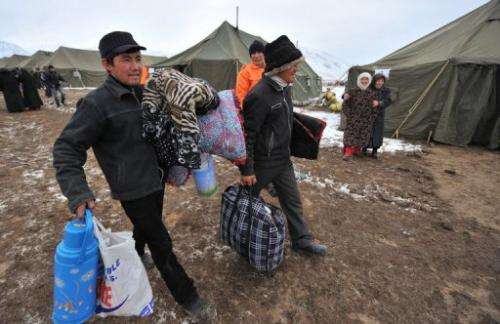Water tensions overflow in ex-Soviet Central Asia

The ex-Soviet states of Central Asia are engaged in an increasingly bitter standoff over water resources, adding another element of instability to the volatile region neighbouring Afghanistan.
Plans in mountainous but energy-poor Tajikistan and Kyrgyzstan for two of the world's biggest hydro-electric power stations have enraged their powerful downstream neighbour Uzbekistan which fears losing valuable water.
Russia as well as the other Central Asian states of Kazakhstan and Turkmenistan are also being pulled into a dispute which dates back to the allocation of resources when the Soviet Union broke up in 1991.
Uzbek President Islam Karimov warned on a visit to Kazakhstan in September that the battle over water resources could sharpen tensions to such an extent it could spark not just "serious resistance but war".
Tajikistan, still recovering from a 1990s civil war and blighted by energy shortages, wants to revive a Soviet-era project to build the Rogun dam over the Vakhsh River. If completed, it would be the world's biggest and stand 335 metres (1,150 feet) tall.
Kyrgyzstan, meanwhile, wants to build a project that was also conceived in Soviet times—the Kambarata-1 dam over the Naryn River that would stand 275 metres (900 feet) high.
Crucially, Russian President Vladimir Putin has given Moscow's backing to the Kyrgyz project while remaining considerably more circumspect about the even more controversial Rogun Dam.
The World Bank is supporting assessment studies on the social, economic and environmental impact of building the Rogun Dam, but emphasises it has made no financial commitment towards supporting construction of the power plant.
"I think that all the countries of the region have to take direct participation in all these projects for the worries to disappear," Putin said on a visit to Kyrgyzstan last month where he supported the Kambarata-1.
Asked about the Rogun Dam, he said: "We must pay attention to the worries of all the countries of the region, including Uzbekistan and lift all the problems that cause these worries. This is possible."
'Soviet megalomania?'
Russia appears to be using the dispute for its own strategic ends, winning valuable commitments from Kyrgyzstan and Tajikistan to host Russian bases up to 2032 and 2042 respectively.
"The conflict has entered a new phase after the long term military agreements signed between Russia and Kyrgyzstan and Tajikistan," said Tajik political analyst Saimuddin Dustov.
Regional analysts say that the dispute risks creating a dangerous fissure in Central Asia as both sides seek to attract supporters to their respective camps.
"Tashkent has started to gather its strength and is attracting Kazakhstan and Turkmenistan onto its side," said Tajik political analyst Abdugani Mamadazimiov.
"If there is not a joint solution then there is going to be a schism."
For Tajikistan, building the dam is a major strategic priority—every winter, the power crisis means most Tajiks are only able to have three hours of electricity every day.
President Emomali Rakhmon has vowed Tajikistan will use its natural resources "for the benefit of its people" while adhering to international laws.
Yet his position does not find much favour in Uzbekistan, Central Asia's most populous nation with a population of almost 30 million and a top cotton producer.
It fears losing supplies for irrigating fields, suffering shortages over the summer and experiencing the cataclysmic effects of an earthquake around the Rogun Dam.
Central Asian states are haunted by the environmental catastrophe of the Aral Sea that lies between Kazakhstan and Uzbekistan which since the 1960s has lost most of its water due to Soviet irrigation projects.
On a visit to Kazakhstan in September, Karimov accused Tajikistan and Kyrgyzstan of forgetting that rivers are "cross-border" resources.
"The Rogun Dam and Kambarata-1 were designed in the 1960s-1970s when we were all living in the Soviet Union and suffered from one thing—megalomania. But times change."
(c) 2012 AFP

















